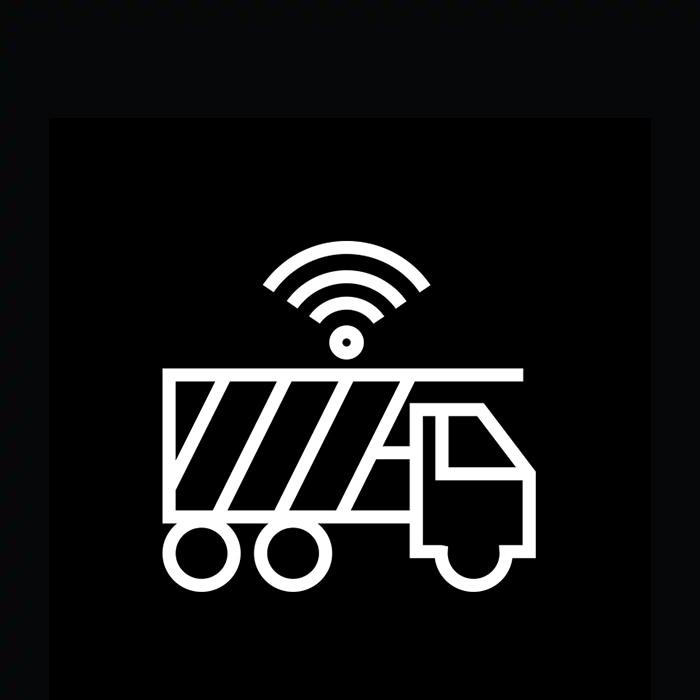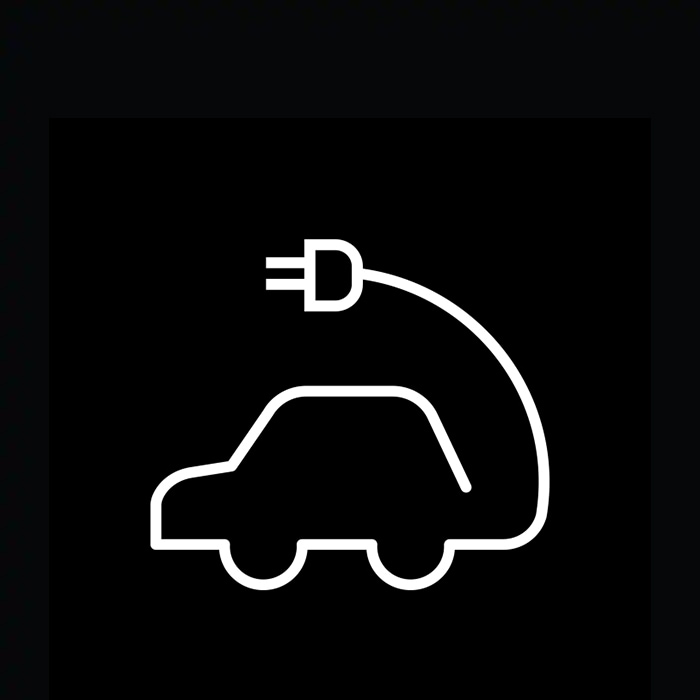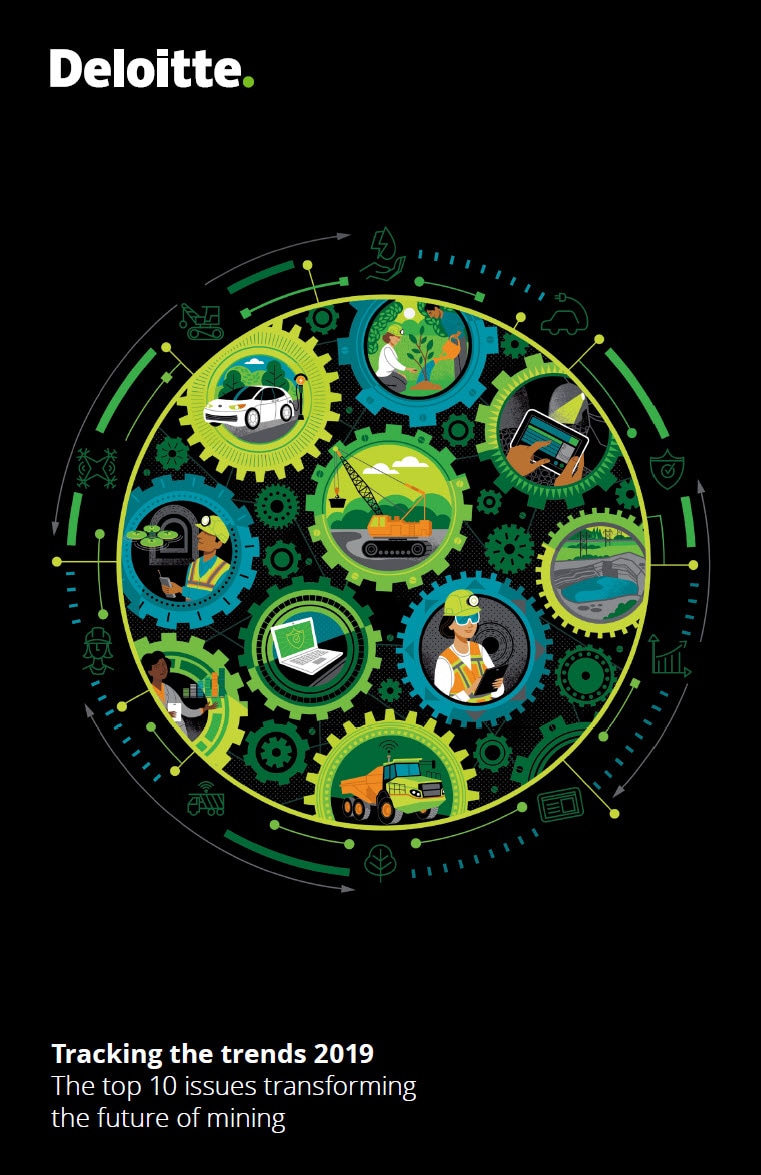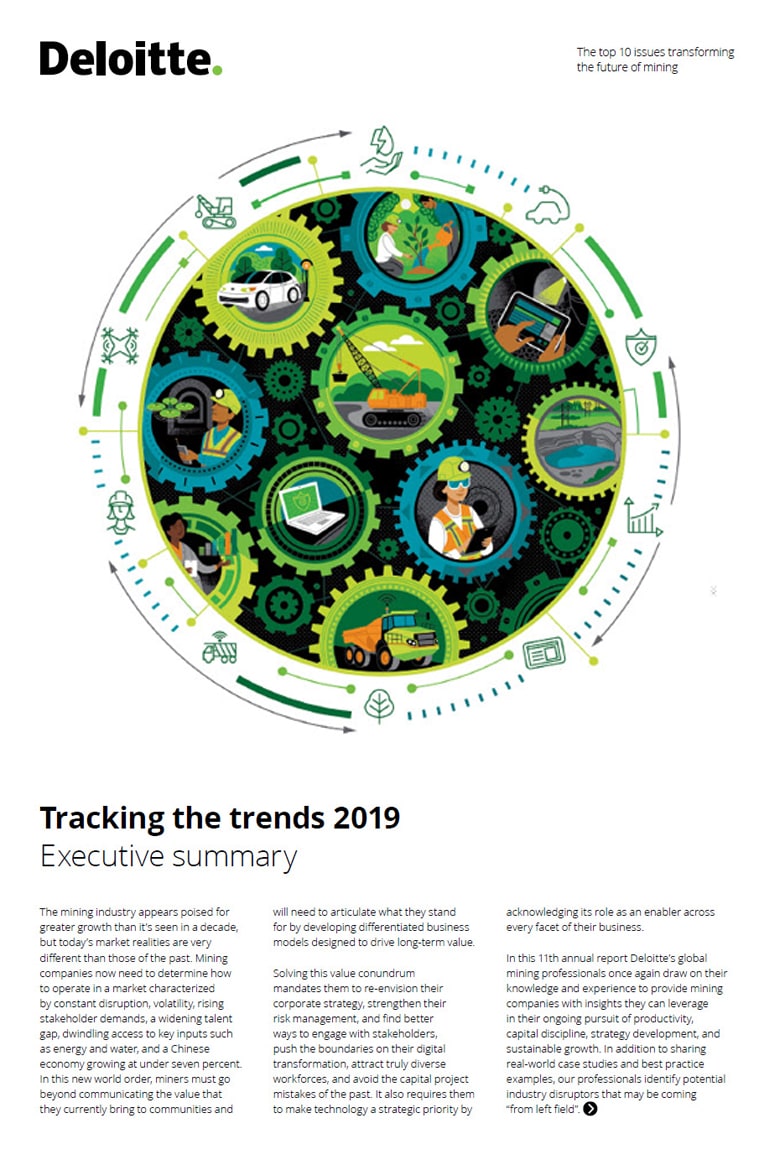Article
Tracking the trends 2019
The top 10 issues transforming the future of mining
Solving the value conundrum
Disruption and volatility have become the new constant for the mining sector—grappling with issues like rising stakeholder demands, talent shortages, tarnished reputation, an evolving threat landscape, and dwindling access to key resources such as energy and water. What leading strategies can miners deploy to succeed in this dynamic business environment?
To thrive into the future, companies must re-envision corporate strategies, boost risk management approaches, and improve relationships with stakeholders, in addition to making rapid strides in digital transformation, expanding capital spend, and fostering an environment of diversity and inclusion.
Now in its 11th year, the 2019 Tracking the trends reveals the top 10 trends that should be on every mining company's agenda. Our global mining professionals once again share insights that miners can leverage in their ongoing pursuit for productivity, capital discipline, strategy development, and sustainable growth.
Download the report to find out what’s in-store for miners this year.
2019 mining trends

Rethinking mining strategy
Embedding the discipline to deliver measurable value across the cycle

In today's complex mining environment, companies can no longer anchor their strategic planning cycles around merely producing the greatest amount of ore at the lowest cost. Miners have not yet sufficiently broadened their strategic outlook to take a range of critical industry shifts into account—the role of individual assets in the portfolio, balancing risk and return, the path of value creation etc. Some mining companies are taking steps to reposition for the future by revisiting their underlying business models and making new strategic investments. While it remains to be seen whether those moves will be sufficiently far-reaching or radical, one thing is clear: management teams serious about long-term value creation must put strategy at the heart of their board-level conversations.

The frontier of analytics and artificial intelligence
Moving up the maturity curve

Despite making impressive strides in the realm of digitization, mining companies are grappling with moving the analytics maturity curve. They have begun expending on analytics and artificial intelligence (AI), not only to manage volumes of data but also to turn it into an advantage. Identifying the root causes and answering all the "what", "why", and "how" questions can help companies move the needle from predictive analytics to prescriptive analytics. This trend presents some interesting mining-specific use cases to help realize the value for the business outcomes of analytics and AI.

Managing risk in the digital era
Exploring a new approach to controls and risk management

In a landscape characterized by mounting tariffs, potential trade wars, cyber threats, and operations in less stable regions, mining companies can't view risk management from a mere compliance perspective. Moving beyond the siloed approach, they must take a more holistic outlook of risk management and deploy the next generation of internal audit─Internal Audit 3.0. How does Internal Audit 3.0 embrace cognitive technologies like AI and analytics to help companies manage risk?

Supply chain digitization
Why innovation requires integration

Disruptive technologies like AI, industry 4.0, cognitive technologies, robotics, cloud computing, and the Internet of Things (IoT) are combining to create digital enterprises that are both interconnected and capable of more informed decision-making. To harness the business growth and create a more interconnected and responsive supply chain, mining companies must switch gears from the traditional supply chain to a digital supply network (DSN). The DSN employs real-time data to accelerate decision-making, enhance transparency, foster multidirectional communication, and enable collaboration across the entire supply network.

Driving sustainable shared social outcomes
Finding value beyond compliance

Until recently, mining company social spend has been seen as a cost of compliance, rather than a way to deliver measurable and sustainable benefits to host countries and communities. If mining companies hope to drive different social outcomes, that dynamic has to change. A social enterprise is an organization whose mission combines revenue growth and profit-making with the need to respect and support its environment and stakeholder network. Finding value beyond compliance is no easy task. It requires miners to listen more closely to their constituents to determine what stakeholders truly want, and then to shift their operational processes in response.

Exploring the water-energy nexus
Making the case for a systematic approach

As one of the world’s most energy and water intensive industries, the mining sector has long struggled to secure uninterrupted access to these critical inputs. The true value from energy management can only be derived by addressing the triple bottom line of social, environmental, and financial performance. Companies that succeed in this effort can reduce their energy consumption by 15-20 percent in existing mines, and up to 50 percent for new mines. What approach can companies take to better manage water and energy use?

Decoding capital projects
Learning from past mistakes

With the commodity price meltdown, many mining companies were compelled to operate leaner—wedging their capital expenditure. The sector's capital investments in 2017 dropped by almost two-thirds compared to the US$80.8 billion peak of 2012. With the cycle turning, mining capex is expected to exceed US$40 billion in 2020. Companies need to avoid the mistakes of the past and engage in a wave of new capital projects to offset production declines and meet the demand of commodities.

Reimagining work, workers, and the workplace
A blueprint for the future

The mining industry faces a changing talent landscape, with digitization necessitating new skillsets, a massive generational shift when considering C-suite succession planning and a younger generation of workers who measure loyalty to an employer in months instead of years. To prepare for this imminent future, organizations need to clarify not only their business goals and aspirations, but also the role that their talent strategy should play to deliver on them.

Diversity and inclusion programs in the workplace
From theory to practice

The way mining companies are approaching diversity and inclusion is shifting. They are announcing ambitious corporate diversity targets, but are far from achieving the goals, given the scarcity of qualified diverse talent. The challenge is more numerical than cultural. To move the dial on inclusion strategies, they need to cultivate new behaviors, attitudes, and policies—this is imperative to transform the vision of diversity and inclusion into a permanent reality.

Demanding provenance
EVs and battery minerals provoke the desire for provenance

The rising demand for electric vehicles (EVs) is increasing demand for EV battery materials such as cobalt, lithium, graphite, and copper. However, socially-conscious consumers are now questioning the provenance of raw materials. As a result, downstream customers, such as automotive manufacturers and technology giants, are demanding ethically-sourced minerals. This is putting unprecedented pressure on mining companies to create a more transparent interface with their customers and driving the adoption of technologies such as blockchain to enhance the traceability of commodities.
Listen to our leaders’ perspectives on 2019 mining trends
Dig Deep Podcast: The Key Mining Trends in 2019
Interview with Andrew Swart
The mining industry is changing faster than ever, resulting in both greater growth potential, as well as more disruption and volatility than in years past.
In this episode of the Dig Deep Podcast, Rob Tyson, Founder and Director of Mining International Ltd. interviews Andrew Swart, Deloitte’s Global Consulting Mining & Metals Leader and briefly discusses the key trends affecting the mining industry in 2019.
Executive summary 2018
The 2018 edition of Tracking the trends will mark the tenth year of release. Deloitte examines the top 10 trends that should be on mining company’s agenda in 2018.
Over the past decade, commodity prices reached both historic highs and historic lows, mining companies engaged in both significant acquisitions and consolidation, and operational realities shifted irrevocably in the face of a digital revolution. For an industry considered staid, change has been surprisingly constant. However, unlike previous cycles, mining companies appear to have learned from the lessons of the past. In paving new paths for the future, the aim now is to change for the better.
In this tenth anniversary report, Deloitte’s global mining professionals once again share their experiences to help identify strategies mining companies can take to smooth out the recovery and minimize the industry’s historical boom and bust cycle. This year, our professionals also share their “best guess outlook” for the future by identifying potential industry disruptors on the horizon.



